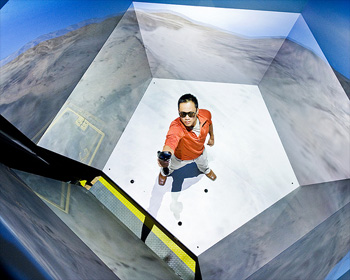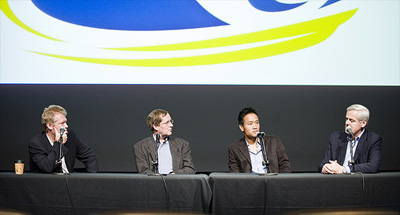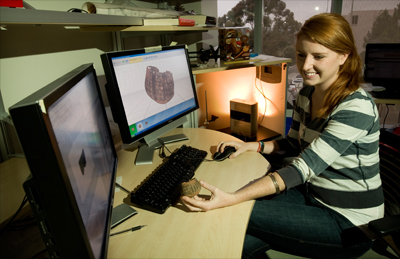National Geographic Taps UC San Diego Students for Technology Solutions
San Diego and Washington, D.C., April 20, 2010 -- A West Coast campus famous for its high-tech research is now becoming known for its global reach in cultural heritage. Faculty and students are already searching for the lost tomb of Genghis Khan and a masterpiece mural by Leonardo da Vinci not seen in 450 years, and now many more students will get the opportunity to blaze new technology trails in the name of global exploration.
|
“The university has a well-deserved reputation of scientific innovation, but it’s important to remember that technology is there to serve society, including the conservation of our cultural heritage,” said UC San Diego Chancellor Marye Anne Fox. “The National Geographic Society exemplifies the very best in global exploration and this agreement gives many more students the opportunity to make a contribution to some of the greatest discoveries of our world and our past.”
National Geographic sees UCSD students as an untapped source of new ideas and ingenuity that could be useful to projects funded by the Society, particularly in the area of remote imaging.
“National Geographic has been involved in developing remote imaging technology for research and exploration for many years,” said Terry Garcia, NG’s Executive Vice President for Mission Programs. “Once we saw the amazing depth of knowledge among UCSD researchers we are funding, we recognized that by giving students the opportunity to collaborate with NG staff on solving real-world engineering problems, it could be a win-win situation.”
|
The UCSD-NGS Engineers for Exploration program will invite honors-level senior undergraduates and graduate students to submit applications to participate in the program. Those interested in earning credit for independent study or undergraduate engineering design coursework can apply to participate in one of the inaugural projects jointly approved by UCSD and National Geographic, with the latter providing core funding for up to three projects per quarter.
Selected students will then be assigned to teams supervised by faculty advisors drawn from an interdisciplinary group of professors from computer science, electrical and mechanical engineering, oceanography and nanoengineering. Each team will do background research, discuss possible technology solutions, and conduct a brainstorming session via high-definition videoconferencing with National Geographic engineers and explorers to determine the best design approach.
|
Lin is one of four researchers in CISA3 to receive funding in the past year from National Geographic. CISA3 director Maurizio Seracini has been a National Geographic Fellow since 2008, in connection with the NG-sponsored search for Leonardo da Vinci’s long-lost “Battle of Anghiari” mural. UCSD archaeology professor Tom Levy and his graduate student Kyle Knabb have received grants in connection with a project that is exploring the eastern Mediterranean’s oldest copper-age mining complex, in what is today southern Jordan.
One of the first projects will involve creating a way to transmit video wirelessly from underwater cameras. Students are also expected to work on environmental sensors and other tools for deployment on projects such as National Geographic’s Big Cats Initiative, a comprehensive program announced last October to rally public support and bolster conservation efforts worldwide for lions, leopards and other large feline species in the wild.
Another early project could have students developing so-called ‘crowd-sourcing’ solutions to get citizen-scientists involved in Albert Lin’s scrutiny of satellite images for tell-tale clues to the location where Genghis Khan was buried nearly 800 years ago.
“Non-invasive imaging tools have become so portable and powerful that we should be able to pinpoint underground structures,” added the UCSD alum, ’04, M.S. ’06, Ph.D. ’08 (all from the Jacobs School of Engineering). “We don’t need a shovel to identify a burial site, especially one the size of what we believe would have surrounded Genghis Khan’s grave. This is new technology that will allow us to preserve the past while also giving the world images and computer models that eliminate the need to dig up ruins to preserve cultural heritage.”
Lab facilities will include Calit2’s Circuits, Nano3 and visualization labs, as well as the Laboratory for Underwater Imaging at the Scripps Institution of Oceanography, and design labs in Electrical and Computer Engineering, Mechanical and Aerospace Engineering as well as Computer Science and Engineering departments of the Jacobs School.
Inventions or discoveries emerging from the UCSD-NGS partnership that are made jointly will be jointly owned. If, however, technology is invented solely at UCSD but used in the context of the partnership, the university will grant National Geographic a royalty-free, non-exclusive license in perpetuity.
Note to Students: On May 5 from 12:30-1pm Pacific time, the UCSD-NGS program will hold a kickoff event at Calit2 for interested students. National Geographic Executive Vice President for TV Mark Bauman and NGS engineers will participate remotely via high-quality videoconferencing from National Geographic headquarters in Washington, D.C. The orientation session will make seniors and grad students aware of the new opportunities to work on National Geographic-related projects.
Related Links
UCSD-NGS Engineers for Exploration
National Geographic
Big Cats Initiative
UC San Diego
CISA3
Calit2
Media Contacts
Doug Ramsey, Calit2, 858-822-5825, dramsey@ucsd.edu or Barbara Moffet, NGS, 202-857-7756, bmoffet@ngs.org



